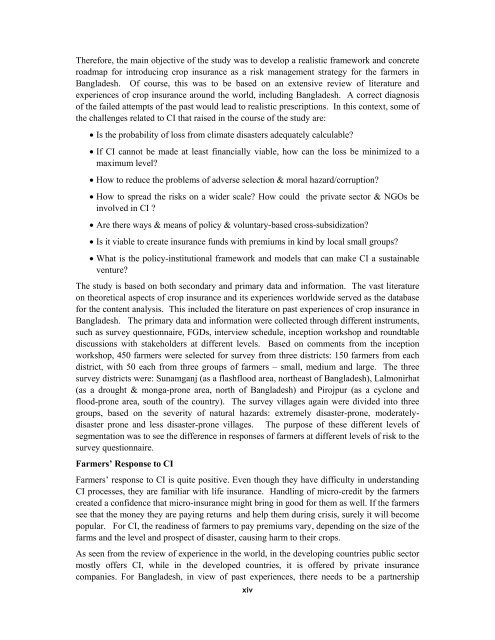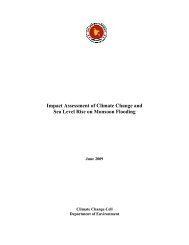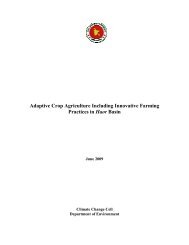Crop Insurance as a Risk Management Strategy in Bangladesh
Crop Insurance as a Risk Management Strategy in Bangladesh
Crop Insurance as a Risk Management Strategy in Bangladesh
You also want an ePaper? Increase the reach of your titles
YUMPU automatically turns print PDFs into web optimized ePapers that Google loves.
Therefore, the ma<strong>in</strong> objective of the study w<strong>as</strong> to develop a realistic framework and concrete<br />
roadmap for <strong>in</strong>troduc<strong>in</strong>g crop <strong>in</strong>surance <strong>as</strong> a risk management strategy for the farmers <strong>in</strong><br />
<strong>Bangladesh</strong>. Of course, this w<strong>as</strong> to be b<strong>as</strong>ed on an extensive review of literature and<br />
experiences of crop <strong>in</strong>surance around the world, <strong>in</strong>clud<strong>in</strong>g <strong>Bangladesh</strong>. A correct diagnosis<br />
of the failed attempts of the p<strong>as</strong>t would lead to realistic prescriptions. In this context, some of<br />
the challenges related to CI that raised <strong>in</strong> the course of the study are:<br />
• Is the probability of loss from climate dis<strong>as</strong>ters adequately calculable?<br />
• If CI cannot be made at le<strong>as</strong>t f<strong>in</strong>ancially viable, how can the loss be m<strong>in</strong>imized to a<br />
maximum level?<br />
• How to reduce the problems of adverse selection & moral hazard/corruption?<br />
• How to spread the risks on a wider scale? How could the private sector & NGOs be<br />
<strong>in</strong>volved <strong>in</strong> CI ?<br />
• Are there ways & means of policy & voluntary-b<strong>as</strong>ed cross-subsidization?<br />
• Is it viable to create <strong>in</strong>surance funds with premiums <strong>in</strong> k<strong>in</strong>d by local small groups?<br />
• What is the policy-<strong>in</strong>stitutional framework and models that can make CI a susta<strong>in</strong>able<br />
venture?<br />
The study is b<strong>as</strong>ed on both secondary and primary data and <strong>in</strong>formation. The v<strong>as</strong>t literature<br />
on theoretical <strong>as</strong>pects of crop <strong>in</strong>surance and its experiences worldwide served <strong>as</strong> the datab<strong>as</strong>e<br />
for the content analysis. This <strong>in</strong>cluded the literature on p<strong>as</strong>t experiences of crop <strong>in</strong>surance <strong>in</strong><br />
<strong>Bangladesh</strong>. The primary data and <strong>in</strong>formation were collected through different <strong>in</strong>struments,<br />
such <strong>as</strong> survey questionnaire, FGDs, <strong>in</strong>terview schedule, <strong>in</strong>ception workshop and roundtable<br />
discussions with stakeholders at different levels. B<strong>as</strong>ed on comments from the <strong>in</strong>ception<br />
workshop, 450 farmers were selected for survey from three districts: 150 farmers from each<br />
district, with 50 each from three groups of farmers – small, medium and large. The three<br />
survey districts were: Sunamganj (<strong>as</strong> a fl<strong>as</strong>hflood area, northe<strong>as</strong>t of <strong>Bangladesh</strong>), Lalmonirhat<br />
(<strong>as</strong> a drought & monga-prone area, north of <strong>Bangladesh</strong>) and Pirojpur (<strong>as</strong> a cyclone and<br />
flood-prone area, south of the country). The survey villages aga<strong>in</strong> were divided <strong>in</strong>to three<br />
groups, b<strong>as</strong>ed on the severity of natural hazards: extremely dis<strong>as</strong>ter-prone, moderatelydis<strong>as</strong>ter<br />
prone and less dis<strong>as</strong>ter-prone villages. The purpose of these different levels of<br />
segmentation w<strong>as</strong> to see the difference <strong>in</strong> responses of farmers at different levels of risk to the<br />
survey questionnaire.<br />
Farmers’ Response to CI<br />
Farmers’ response to CI is quite positive. Even though they have difficulty <strong>in</strong> understand<strong>in</strong>g<br />
CI processes, they are familiar with life <strong>in</strong>surance. Handl<strong>in</strong>g of micro-credit by the farmers<br />
created a confidence that micro-<strong>in</strong>surance might br<strong>in</strong>g <strong>in</strong> good for them <strong>as</strong> well. If the farmers<br />
see that the money they are pay<strong>in</strong>g returns and help them dur<strong>in</strong>g crisis, surely it will become<br />
popular. For CI, the read<strong>in</strong>ess of farmers to pay premiums vary, depend<strong>in</strong>g on the size of the<br />
farms and the level and prospect of dis<strong>as</strong>ter, caus<strong>in</strong>g harm to their crops.<br />
As seen from the review of experience <strong>in</strong> the world, <strong>in</strong> the develop<strong>in</strong>g countries public sector<br />
mostly offers CI, while <strong>in</strong> the developed countries, it is offered by private <strong>in</strong>surance<br />
companies. For <strong>Bangladesh</strong>, <strong>in</strong> view of p<strong>as</strong>t experiences, there needs to be a partnership<br />
xiv





